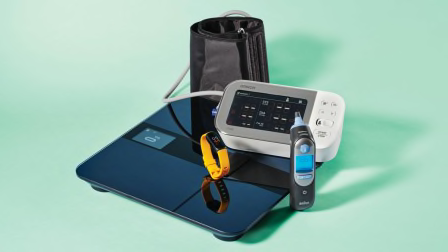Best In-Ear Thermometers of 2025
Our testing found that ease of cleaning is surprisingly important. Here’s what else to know.
When you shop through retailer links on our site, we may earn affiliate commissions. 100% of the fees we collect are used to support our nonprofit mission. Learn more.

When your child is sick, monitoring fever symptoms becomes something like a part-time job. And when you’re checking and rechecking (and rechecking . . .) your little one’s temperature, the right thermometer is key, not only for accuracy but also for peace of mind. The best thermometers we tested were accurate, as well as easy to clean, which our experts found to be one of the most important criteria for the best in-ear thermometers.
The 10 thermometers in our ratings take temperature via the ear, and half of them also have the capability to take temperature via the temporal artery—meaning you place the thermometer against the forehead or temple.
Why Ease of Cleaning Is Critical
You might think a thermometer being easy to clean is mostly a nice bonus, but we found that ease of cleaning actually had a big impact on accuracy in some cases. Infrared thermometers measure temperature based on the detection of infrared light via the sensor in the thermometer’s probe, says Bernie Deitrick, who led our thermometer testing. When you place a probe into an ear, it may come away with earwax stuck to the surface. That earwax can partly block the infrared sensor, meaning the thermometer registers less infrared light—and thus, a lower temperature. We found even small specks of wax could cause noticeable differences in the temperature readings. That’s why ease of cleaning is so important. For a few thermometers, the design of the probe, with tiny ridges around the glass surface, made it difficult to get the glass fully clean.
Thermometers that use a single-use plastic probe cover—which clicks on over the probe—don’t have this problem; they’re very easy to keep clean since all you need to do is toss the used plastic cover. But a majority of the thermometers we tested weren’t made to work with disposable plastic covers.
If you use the temporal artery feature on the thermometers that offer it, you also don’t need to worry about this, because the thermometers come with a cap that’s placed on the probe to take a forehead reading. It’s just in the case of taking the temperature in the ear without a probe cover that you could run into this problem.
All the thermometers in our ratings earned high marks for accuracy and consistency, so as long as you’re using each of them with a clean probe, you can feel confident about the results. Just read the instructions carefully to make sure you’re using the correct procedure, placement, and cleaning methods. Deitrick recommends practicing with your child at a time when they’re healthy, so you know what to do when it’s the middle of the night and they’re not feeling well. This will also give you a sense of their normal temperature, so you’ll know how far from that they are when they’re running a fever.
Best In-Ear Thermometers
While all 10 thermometers in our ratings earned decent marks for accuracy and consistency, these five top picks were also easy to clean. Members can access our full thermometer ratings.
How We Test Thermometers
We used each thermometer on volunteers without a fever and compared the temperature readings to results with a mercury thermometer. Our accuracy testing included both in-ear and forehead readings for those thermometers that have the capability to take both types of measurements.
We didn’t want to drag anyone into our labs while they were sick, so to test the products’ accuracy at higher temperatures, we created a dummy ear canal, placed it in a 104° F water bath, and tested how accurately each thermometer read the temperature within the dummy canal.
To test each thermometer’s consistency, we took five repeated readings with each to assess how much variability it produced between readings. Higher-scoring thermometers varied little from reading to reading on the same person (or the same dummy ear canal).
We took note of each thermometer’s features, like backlighting (which makes it easier to see the reading in the dark), memory of previous readings (which can be helpful for tracking), audio fever indicators (which beep when the measured temperature exceeds a certain level), and more.
Finally, we evaluated how much effort it took to get the glass surface of the probe clean after use.






























